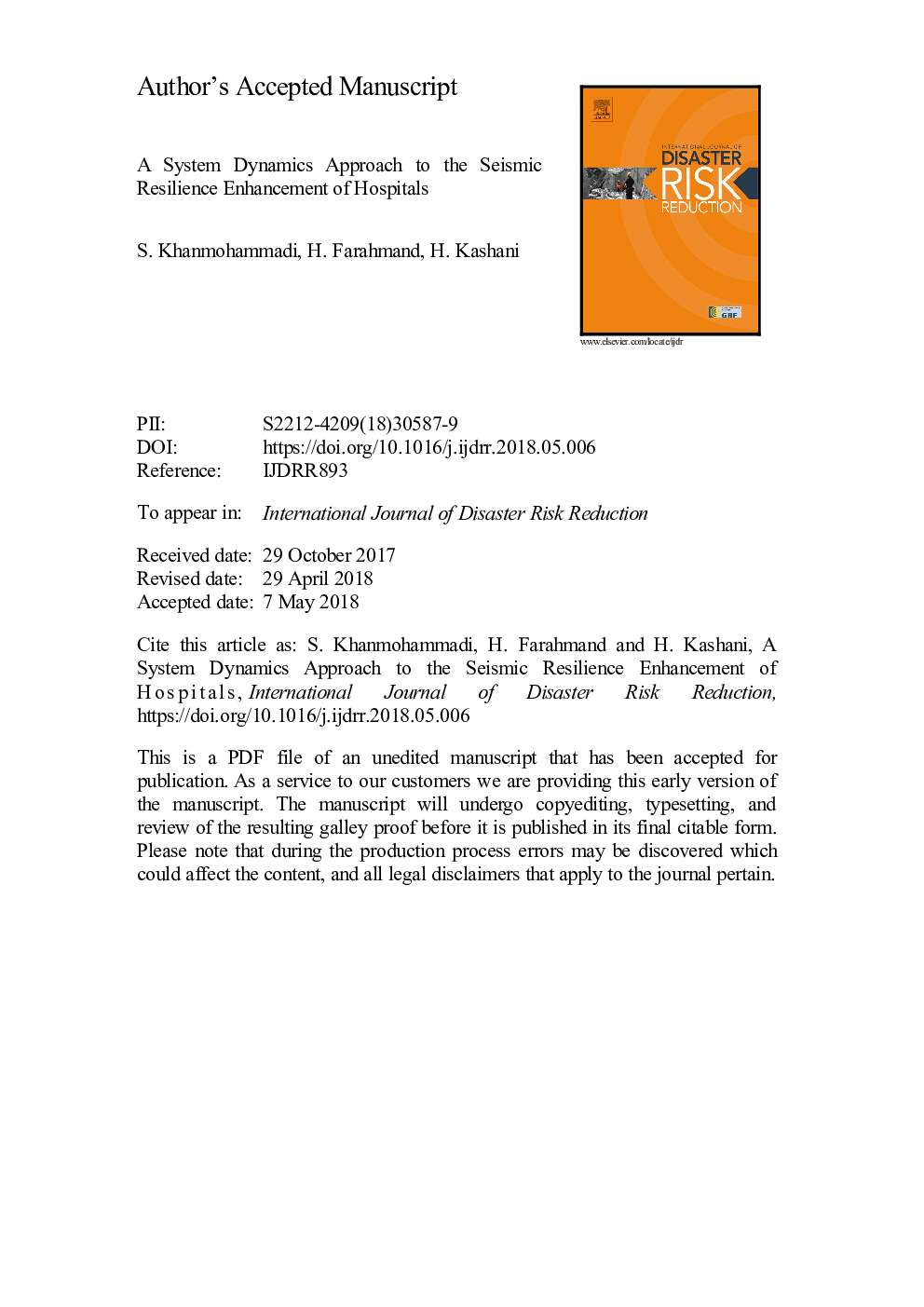| کد مقاله | کد نشریه | سال انتشار | مقاله انگلیسی | نسخه تمام متن |
|---|---|---|---|---|
| 7471069 | 1485138 | 2018 | 35 صفحه PDF | دانلود رایگان |
عنوان انگلیسی مقاله ISI
A system dynamics approach to the seismic resilience enhancement of hospitals
ترجمه فارسی عنوان
رویکرد دینامیک سیستم به افزایش قابلیت انعطاف پذیری لرزه ای بیمارستان ها
دانلود مقاله + سفارش ترجمه
دانلود مقاله ISI انگلیسی
رایگان برای ایرانیان
کلمات کلیدی
انعطاف پذیری، بهبود، دینامیک سیستم، بیمارستان، زمین لرزه، شبیه سازی،
ترجمه چکیده
در نتیجه زمین لرزه ها، بیمارستان ها نقش حیاتی در درمان تلفات را ایفا می کنند. در بسیاری از موارد، عوامل اصلی بیمارستان (به عنوان مثال ساختمان، کارکنان، موجودی پزشکی، سیستم های فنی و تجهیزات پزشکی) تحت تاثیر زلزله قرار دارند. برای رسیدگی به افزایش تقاضا، بیمارستان های تحت تأثیر باید به نحو موثری بهبود یابند. بازیابی بیمارستان یک فرایند پیچیده و پویا است، زیرا هر جزء نیاز به نوع خاصی از منابع را برای بازیابی دارد. علاوه بر این، بازیابی هر یک از اجزای نه تنها بر عملکرد آن تأثیر می گذارد، بلکه در بازیابی کلی بیمارستان هم نقش دارد. مدیران بیمارستان نیاز به مدل سازی فرایند بازیابی پیچیده را پس از یک زلزله آینده به منظور تصمیم گیری های حیاتی در مورد مقدار منابع سرمایه گذاری در بازیابی هر یک از مولفه ها. این مقاله یک مدل شبیه سازی دینامیکی سیستم ارائه می دهد که مشخصه پویایی روند بهبود پس از زلزله در یک بیمارستان است. این مدل تاثیرات آسیب جزئی و کمبود منابع را بر کیفیت خدماتی که توسط بیمارستان ارائه می شود تعیین می کند. همچنین جریان جریان بیماران، پویایی عملیات درمان و تلاش های بهبودی را که برای کاهش تاثیرات زلزله بر روی هر بخش بیمار انجام می شود، در نظر می گیرد. سپس عملکرد و انعطاف پذیری یک بیمارستان را تعیین می کند. این مدل مدیران را قادر می سازد تا درک کنند که چگونه تصمیم گیری خود را در مورد استفاده از منابع موجود قبل و بعد از زلزله بر عملکرد بیمارستان تاثیر می گذارد. این می تواند به مدیران در ارزیابی تاثیرات سیاست های مختلف آمادگی بر روی انعطاف پذیری بیمارستان های آنها کمک کند.
موضوعات مرتبط
مهندسی و علوم پایه
علوم زمین و سیارات
فیزیک زمین (ژئو فیزیک)
چکیده انگلیسی
In the aftermath of earthquakes, hospitals serve the critical role of treating casualties. In many cases, the key components of a hospital (i.e., the building, staff, medicine inventory, technical systems, and medical equipment) are affected by an earthquake. To handle the demand surge, affected hospitals should recover in an effective manner. Hospital recovery is a complex and dynamic process because each component requires specific types and amount of resources to recover. Furthermore, the recovery of each component not only affects its performance but also plays a role in the overall hospital recovery. Hospital administrators need to model the complex recovery process after a future earthquake in order to make critical decisions regarding the amount of resources invested in the recovery of each component. This paper proposes a system dynamics simulation model that characterizes the dynamics of the post-earthquake recovery process of a hospital. The model determines the impacts of component damage and resource shortage on the quality of services that are provided by the hospital. It also considers the flow of patients, the dynamics of treatment operations, and the recovery efforts that are implemented to mitigate the impacts of an earthquake on each hospital component. It then quantifies the functionality and resilience of a hospital. The model provides the administrators with an insight into how their decisions regarding the use of available resources before and after an earthquake affect the hospital functionality. It can assist administrators in assessing the impacts of various preparedness policies on the resilience of their hospitals.
ناشر
Database: Elsevier - ScienceDirect (ساینس دایرکت)
Journal: International Journal of Disaster Risk Reduction - Volume 31, October 2018, Pages 220-233
Journal: International Journal of Disaster Risk Reduction - Volume 31, October 2018, Pages 220-233
نویسندگان
S. Khanmohammadi, H. Farahmand, H. Kashani,
